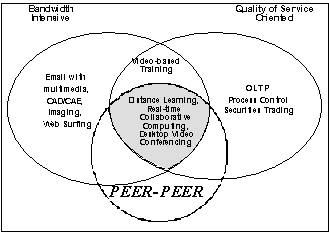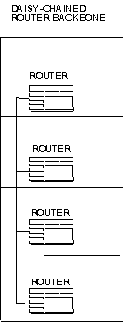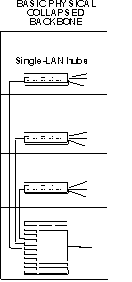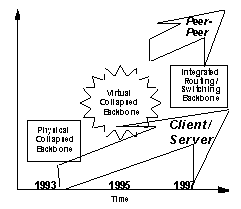 Figure
1
Figure
1
Managing the transition to switched internetworking
The networking industry is entering a critical transition period in which networks must move from the current hub/router model to the integrated routing/switching fabrics of the future. As part of this transition, network vendors have recently unleashed a tremendous diversity of switching and ATM products to deliver more bandwidth and less latency.
The switched internetworking model represents a major paradigm shift in the way internetworks are built and operated. Switch networks use ATM and LAN switching and intelligent virtual-networking software to increase bandwidth and to virtualise the way users access the network. With virtualisation, a switched internetwork offers users high-speed access to servers and other resources without the constraint of the network's physical layout. Tightly-coupled virtual workgroups and virtual departments can be configured and administered as cohesive units even though the users are spread out all over a building or ultimately, a WAN. When properly deployed, the switched internetwork is an ideal vehicle for emerging multimedia applications that will put extreme and specific demands on networks in the very near future.
But as alluring as switched internetworking can be, it is a very challenging architecture to deploy in multiprotocol, multiplatform enterprise environments. As with current hub and router networks, switched internetworks need the full complement of network services, including: end-to-end transport, robust network management, traffic control policies, planning and design tools. Without a comprehensive, top-to-bottom, end-to-end, life-cycle model for switched internetworking, it is certain that the migration would falter. And if the move to switching isn't executed properly, equipment will be become obsolete needlessly and users won't get the network performance they need for the next generation of interactive, multimedia applications.
Enter BaySIS
Bay Networks Switched Internetworking Services (BaySIS) is a detailed architectural framework that ensures Bay Networks products are engineered to meet current and developing needs in this challenging transition period to switched networks. BaySIS has an advantage that no other vendor's products have, because it unites the four critical networking services transport, policy, operations, and design in mixed switching, routing, and shared media environments (see Figure 1).
Transport and Policy Many of the industry's newly unveiled LAN and ATM switches address the increasing need to support bandwidth-intensive, delay-sensitive applications. But unfortunately switching by itself falls far short of actual end-user requirements for fully functional switched internetworks. BaySIS avoids narrow, nonstandards-based approaches and embraces the full range of transport issues (ATM LAN switching, multiprotocol routing, virtual LANs and shared-media LAN connectivity) that are necessary to migrate to a switched internetwork. This approach also addresses all an organisations hub and router equipment, as well as the next generation of high-speed switches.
All BaySIS components give administrators a high degree of control over traffic flows within and among workgroups. Traffic management policies are important in router/hub networks, and they become even more important in switched architectures to ensure specific levels of quality-of-service, security and priority. As switching evolves, BaySIS network policy services are the difference between having a lot of bandwidth and having a lot of intelligently managed bandwidth.
Operations and design Reliable enterprise internetworks require network management and design tools that address the entire architecture and its life cycle: planning, design, configuration, monitoring, diagnostics, fault management and migration.
BaySIS addresses these needs with Optivity, an industry-leading set of applications and products that target every device in the Bay Networks product family, including advanced LAN and ATM switches. The Optivity line includes:
A sophisticated suite of graphical configuration, management and design applications that give network administrators both high- and low-level views of the network and its devices;
Support for many third-party network products through integration of standard management information bases (MIBs);
Add-on management modules that provide advanced monitoring and analysis of hubs, routers and other switched internetwork equipment.
The BaySIS integrated transport, policy, operations and design services gives networked organisations a complete solution that extends to all critical technologies on any required scale: remote users, branch offices, regional centres and enterprise backbones. As network users enter the complex era of switched internetworking, BaySIS will provide a stable migration path from current networks to the advanced switching architectures of the future.
 Figure
1
Figure
1
The Goal:
Integrated Routing/Switching backbones
Industry pundits generally agree that the future of networking will be dominated by hybrid routing/switching architectures that combine the speed and low latencies of switches and the intelligence, security and scalability of routers. This functionality will be made possible by integrated routing/switching technology in hybrid LAN/ATM switches that forward traffic efficiently, using knowledge of Layer 2 addresses, Layer 3 subnetwork topologies and higher-layer application service requirements. Integrated routing/switching networks will provide desktops and servers with high-bandwidth connections to a scalable ATM backbone.
When routing/switching technology is offered by Bay Networks over the next two years, it will give current client/server applications extremely high levels of network service, and it will enable a new breed of multimedia and interactive peer-to-peer applications (see Figure 2). These applications include desktop video conferencing and real-time collaborative computing programs that unite arbitrary groups of users distributed throughout a building or campus.
Also required are network transport services that ensure highly predictable network characteristics (eg. the amount of end-to-end delay that traffic is subjected to).
To ensure that new applications get the deterministic levels of network services they require, BaySIS features a quality-of-service routing protocol: Integrated Private Network-to-Network Interface (I-PNNI). I-PNNI provides all network devices with a common view of complex network topologies that include a mix of multiprotocol LAN devices and backbone equipment. (In September of 1994, Bay Networks submitted I-PNNI to the ATM Forum, where work is underway on standardisation.) When I-PNNI is combined with integrated routing/switching technology, the foundation is laid for applications to make specific quality-of-service requests of the switched internetwork.
I-PNNI and routing/switching devices will be key elements of the BaySIS model. In the near future, these devices will move tremendous volumes of client/server and peer-to-peer traffic via integrated routing/switching backbones that seamlessly integrate frame and cell traffic.
CLIENT / SERVER

Figure 2
Where we are now:
Physical Collapsed Backbones
To understand the implications of the transition to switched internetworking, it is important to examine the role collapsed backbones play in many networked organisations today. Collapsed backbones evolved from early daisy-chained or "distributed" backbones that originally connected routers on each floor of a building with a single cable (see Figure 3). Linear router backbones were a natural first step towards over-all connectivity, as local networks were built a floor at a time.
Distributed riser backbones were sufficient for the early days of internetworking, but they soon became congested because all traffic among routers had to be carried by a single shared cable. And as network activity grew and networks became more mission critical, routers dispersed in wire closets became a liability. Consequently, many networks evolved to a centralised routing function based on a network centre router that connects to LANs on various floors via a star-wired physical collapsed backbone (see Figure 4).
Because the connections between LANs were made across the router's internal backplane, the congestion of the distributed approach is now largely avoided. The physical collapsed backbone also saves money because a single device now supports a number of floors. Finally, the physical collapsed backbone is good for maintenance and troubleshooting because it centralises key devices in an area where they can be monitored and accessed easily.
Many sites today are still based on the basic physical collapsed backbone model, and for moderately loaded networks, the physical collapsed backbone will continue to provide a viable architecture. But as traffic volumes and workgroups grow, the basic physical collapsed backbone often proves inadequate.


Figure 3 Figure 4
Hubs and Physical Collapsed Backbones
Over the past few years many physical collapsed backbones have evolved toward micro-segmented topologies that give users more bandwidth by lowering the number of stations per LAN segment. This has often been accomplished with high-end hub equipment that allows multiple LANs to be present on each floor. Typically, a network centre hub (e.g. System 5000™) will feed a number of LAN segments to each floor. Wire closet hubs on each floor then distribute these LANs to end stations (see Figure 5).
When the basic physical collapsed backbone is augmented with intelligent hubs that provide software-controlled port-configuration, users on different floors can be arranged in a common workgroup that shares the same extended LAN segment. This is the first step towards virtualisation because it allows a single LAN segment to be present on multiple floors. Traffic within the workgroup doesn't need to go through the router and so has lower latency and higher bandwidth characteristics.
For traffic between workgroups, the network centre hub conveys packets to the router, that imposes filtering, security, and fire walls. In this hub-based physical collapsed backbone model, each "virtual" LAN segment requires one connection to the router. In addition to enabling workgroups that span floors, this approach allows servers to be located in the network centre while remaining on the same LAN segment as their clients. Another advantage is the robust network management that the high-end hubs introduce in wire closets and the network centre.

Figure 5
Transition Strategy:
The Virtual Collapsed Backbone
If networks are to migrate smoothly to switching, they need an interim architecture that will efficiently integrate switching into current physical collapsed backbone networks while preserving existing network investments. Some of the latest switching models require the wholesale abandonment of existing hubs, routers and cable plants, but a better transition strategy for the typical network-dependent organisation can be found in the BaySIS virtual collapsed backbone.
The virtual collapsed backbone is "collapsed" in the sense that routing is still provided by a router in the network centre. The virtual collapsed backbone is truly "virtual" because users on different LAN segments throughout the building can be arbitrarily grouped into high-bandwidth, low-latency virtual LANs, which are sometimes referred to as virtual workgroups. There are essentially two forms of the virtual collapsed backbone: the frame-switched virtual collapsed backbone and the cell-switched virtual collapsed backbone.
The Frame-Switched Virtual Collapsed Backbone
When high-speed frame switching devices are introduced into the backbone, many of the limitations of the physical collapsed backbone are eliminated. Frame switches (e.g. Bay Networks Workgroup LAN Switch or LattisSwitch™ Fast Ethernet Switch) provide dedicated 100 Mbps downlinks that ease congestion and cabling complexity in risers. When frame switches are "front-ended" by wire closet hubs, large amounts of flexible bandwidth can be delivered to end users (see Figure 6).
The frame-switching virtual collapsed backbone takes virtualisation of the backbone a step further than the physical collapsed backbone. The switches allow a virtual LAN to be present on multiple floors, but they do not require that a separate cable be run for each virtual LAN, as was the case with the hub-based physical collapsed backbone. This is possible because the frame switches segregate virtual LAN traffic on the 100 Mbps backbone links by tagging each packet with a virtual LAN identifier.
Links between the router and the LAN switch can be provided by existing hub equipment. Traffic within a virtual LAN is switched at wire speeds and very low latencies without going through the router. Traffic among virtual LANs is handled by the router, which imposes filtering, broadcast firewalls, security, and other necessary traffic management services.
Because it preserves existing hub, router, and cable-plant components, the frame-switching virtual collapsed backbone is an immediately available migration step for sites that need virtual LANs, additional bandwidth, and a more streamlined internetwork architecture today. The virtual LANs allow a single logical subnet (e.g. IP, IPX) to span a number of physical LAN segments and floors of a building. This greatly reduces the administrative overhead of user adds, moves, and changes. Multiple virtual LANs can share the same 100 Mbps downlink, so the cabling complexity of the backbone is also greatly streamlined. For organisations that want an incremental step before implementing ATM cell-switches, frame switches are an optimal short- and mid-term backbone solution.
In the long term view, however, frame-switching virtual collapsed backbones have limitations in scalability that will show up when the local backbone is asked to handle very high-levels of intra- and inter-virtual LAN traffic. Sites that need backbone links of greater than 100 Mbps, will want to consider ATM's full-duplex 155 Mbps capacity (310 Mbps). There are also limitations in the degree of quality-of-service features that can be provided by frame switches. For a small or moderate sized workgroup, video applications may get an adequate quality of network service from frame switches. But when users start accessing a variety of interactive and multimedia application servers from all points of the local backbone, ATM is the best approach.
Finally, there's the issue of virtual LAN standards. ATM Forum LAN Emulation is a rapidly maturing standard for interoperability of devices in cell-switched virtual LAN environments. The efforts to standardise virtual LAN protocols for frame switched networks are just getting underway (e.g. recent IEEE efforts). Frame-switched virtual collapsed backbones will provide users in client/server networks with high-levels of performance for years to come. But given the inherent limitations of frame-switched technology, the most strategic backbone approach is found in the cell-switched virtual collapsed backbone.

Figure 6
The Cell-Switched Virtual Collapsed Backbone
A BaySIS cell-switched virtual collapsed backbone augments popular corporate hub and router topologies with an ATM backbone and LAN switching. The ATM backbone runs between a network centre hub (System 5000) and ATM-based LAN switches in the wire closets (Centillion 100™, EtherCell™). Routing is deployed with an ATM Routing Engine module that is added to the Bay Networks Backbone Node router or the System 5000 hub. The ATM module forwards traffic at full-duplex OC-3 speeds (310 Mbps). (See Figure 7).
The ATM-based virtual collapsed backbone exploits a standard structured cable plant so it extends the life of existing physical collapsed backbone backbones without recabling or network disruption. When the shared media physical collapsed backbone downlinks in the risers are converted to 155 Mbps ATM, it is no longer necessary to run many cables to each floor. Each ATM link is divided into multiple logical channels that segregate traffic from LANs into independent "virtual pipes". On each floor, the LAN switches de-multiplex the ATM virtual channels into LANs that are attached directly to endstations or to existing hub equipment.
When the LAN switches are teamed up with port-configuring hubs, switch ports can be "fanned out" to endstations by administrators, who use the hub's graphical configuration software and its simple drag-and-drop mouse interface. In a typical ATM virtual collapsed backbone, some stations will share LAN media while others will get their own dedicated LAN connection. As more bandwidth is needed, the number of users per segment can be reduced in an orderly, efficient process.
To extend the cell-switched virtual collapsed backbone model, network centre hubs can be connected in a campus-wide ATM mesh, allowing high-performance virtual LANs to be extended to multiple buildings. An ATM campus backbone largely eliminates the requirement that workgroup or department resources be physically adjacent.

Figure 7
Virtual Network Routing
In the cell-switched virtual collapsed backbone architecture, broadcast firewalls, traffic management, and security are made possible by a Virtual Network Routing component that resides on an ATM interface in the backbone router.
Virtual Network Routing routes packets among ATM virtual LANs in just the same way that multiprotocol routing takes place among LAN segments on a conventional multiport router. Virtual Network Routing is conceptually equivalent to routing among multiple Frame Relay or X.25 circuits on a single physical router portÑ each circuit gets all the routing services that a physical Ethernet port does (see Figure 8).
Depending on traffic patterns and network loading, a single ATM link between a router and a network centre hub can support from 25 to 50 or more virtual LANs. The ATM virtual channel connections between the router and the LAN switches effectively create a firewall around each virtual LAN that keeps broadcasts and valuable computing resources within the bounds of the workgroup. Virtual Network Routing only routes traffic between virtual LAN workgroups. Traffic within virtual workgroups moves from LAN switch to LAN switch through the building or campus ATM fabric at 155 Mbps and very low latencies. With the LAN virtualisation process, BaySIS virtual collapsed backbone eliminates the physical collapsed backbone's need to establish many physical links between the router and network centre hub.
On sites that require many virtual LANs, the backbone router can be outfitted with multiple ATM interfaces. The Bay Networks Backbone Node router deploys a high-end symmetrical multiprocessing architecture that allows highly-scalable virtual routing for all the virtual LANs in a typical building site, even if traffic loads are extremely heavy.
Virtual connections are established between LAN switches and the Virtual Network Routing router using industry-standard ATM Forum LAN Emulation. Standard LAN emulation client (LEC) software runs in each LAN switch, router, and ATM-attached server. LAN emulation server components run in the network centre hubs. LAN emulation allows the virtual collapsed backbone to interoperate with the full spectrum of multivendor ATM servers and endstation interfaces.
When servers are given ATM interfaces with LAN Emulation software and connected to the cell-switched virtual collapsed backbone, additional benefits become apparent. Like the routers and the LAN switches, the servers can support multiple virtual connections on a single ATM interface. This means that multiple virtual LAN workgroups can access an ATM-based server without going through the router. This is similar to when a server has multiple physical interfaces, each connected to a different LAN. But in this case the multiple connections are virtualised by the ATM server interface. This is an ideal configuration for high-end client/server-oriented multimedia applications (e.g. corporate desktop video training) where users on multiple virtual LANs must access a central server at very high speeds and low latencies.

Figure 8
Traffic Policy and Virtual Network Routing
The backbone router's Virtual Network Routing software treats ATM virtual LANs like just another traffic stream so all of the router's traffic policy resources are available for packet processing. Any Layer 2 or Layer 3 protocol handling feature can be turned ON or OFF for each virtual LAN. For instance, IP could be routed but LAT could be bridged. Router filters based on addresses, protocol types, application types, or other parameters can be established to block or pass traffic between virtual LANs. Security between virtual workgroups can be enforced as well.
For mission-critical traffic flows, the Virtual Network Routing queues can be configured to forward packets at a variety of priority levels. Because familiar router configuration tools are employed, Virtual Network Routing extends routing to ATM without requiring additional training or administrative burden. The same management interface used for non-ATM LAN and WAN interfaces is also used for Virtual Network Routing. From an administrative standpoint, ATM becomes just another interface on the backbone router.
The cell-switched virtual collapsed backbone treats many physical LAN segments like a single virtual LAN. So, the administration of subnet addresses is streamlined significantly. All the stations on a virtual LAN can have the same subnet address. New physical segments can be added to the virtual LAN without creating new subnet addresses. This greatly reduces the number of subnets an organisation requires, effectively "flattening" the network architecture by streamlining the excessive logical hierarchy of traditional router networks. Users can move around within their virtual LAN without changing their addressing.
The ATM-based virtual collapsed backbone allows administrators, over time, to reduce the number of users per segment in a graceful, software-controlled process. Some users may continue to share a LAN via the wire-closet hubs indefinitely. Other users or servers may be given their own dedicated LAN connections. In cases where even greater performance is required, endstations can be given their own ATM interface, which connects to the network centre hub or a workgroup ATM switch (e.g., LattisCell™) that can be located anywhere in the building. Native ATM users get all the benefits of the BaySIS virtual collapsed backbone architecture, including seamless ATM server access and Virtual Network Routing for security and traffic control policy.
Bay Networks I-PNNI
For network-dependent enterprises, the most viable approach to ATM-based internetworks is Bay Networks Integrated Private Network to Network Interface (I-PNNI) protocol. I-PNNI is an extension of the ATM Forum's PNNI protocol that specifies how ATM switches manage end-to-end switched-virtual circuits and quality-of-service in ATM networks. The core of the integrated routing/switching backbone (IR/SB) consists of conventional ATM switches that manage their connections via PNNI. The routing/switching (R/S) edge devices (and "legacy" routers) at the perimeter of the core use I-PNNI to propagate multiprotocol routing information across the ATM fabric. I-PNNI simply adds information to PNNI link-state update messages that allows the perimeter devices to maintain awareness of LAN protocols and Layer 3 subnetwork topologies. This multiprotocol information is transparent to the ATM switches in the core (see Figure 9).
When R/S edge devices run I-PNNI in addition to traditional routing protocols (e.g. OSPF, RIP), they can participate directly in both internetwork and ATM topologies. I-PNNI is not merely an overlay approach that uses the ATM backbone as "dumb" pipes. The R/S edge devices and ATM switches all have full knowledge of the heterogeneous topology and all devices can make intelligent routing decisions based on this information. This is possible because I-PNNI maps routing metric parameters for LAN routing protocols to ATM metrics and vice versa. When I-PNNI is deployed, all the devices (even legacy routers) can use the same routing metrics to calculate routes across the backbone. In some cases, routes provided by legacy routers will be the best path through the IR/SB, depending on the needs of a particular application. Hence existing internetwork resources are preserved.

Figure 9
Enhancing the Cell-Switched Virtual Collapsed Backbone
The ATM virtual collapsed backbone is a great improvement over pure frame-switched networks, but several incremental enhancements will take place as ATM virtual collapsed backbone technology evolves. In the previous examples, each floor is serviced by a discreet ATM-based LAN switch that supplies wire-speed LAN connections to hubs, endstations and servers. But as the technology matures, LAN switching and ATM interfaces will become available as add-in cards for System 5000 hubs that reside on each floor. This enhancement will allow hubs to service users with any mix of switched or shared-media LAN connections from a single chassis (see Figure 10) .
As part of this enhancement, the wire-closet hubs will be outfitted with ATM interfaces that connect directly to the virtual collapsed backbone. With multiple ATM interfaces, these hubs can have redundant, load-balancing ATM links down to the network centre hub. This will allow the virtual collapsed backbone to scale to handle anticipated traffic loads from emerging bandwidth-intensive, delay-sensitive multimedia applications. ATM hub connections can also be used to connect directly to endstations and servers that are outfitted with native ATM interfaces.

Figure 10
Network Operations and Design
The previous discussion of frame Ñ and cell-switched virtual collapsed backbones concentrated on transport and traffic policy. These are powerful solutions in their own right, but they become even more viable when combined with the other dimensions of the overall BaySIS architecture, particularly network management, planning, and design.
Optivity is the key management point for all the daily operational facets of frame-switched virtual collapsed backbones, cell-switched virtual collapsed backbones, and networks that combine both of these backbone approaches. Optivity provides end-to-end troubleshooting, fault management, network configuration, accounting, and asset management. Because virtual collapsed backbones are built with mainstream corporate backbone devices (e.g. System 5000, BN™), it is not necessary to create a new network management and operations system from the ground up. Instead, the proven, easy-to-use Optivity interface is extended to embrace the new ATM and LAN switching functions.
Currently, many administrators use Optivity to configure and diagnose shared media addresses and ports. When virtual collapsed backbone components are added to a network, the same powerful graphical metaphor will be employed to define virtual LAN segments and ATM virtual connections. While switched internetworking approaches from other vendors require multiple management systems to diagnose the entire network, Optivity provides a sophisticated, multi-function management environment that enables end-to-end configuration and control of all devices in the hybrid internetwork. Optivity's streamlined drag-and-drop mouse interface lets administrators use one procedure to define virtual LAN memberships for mixed populations of endstations that are attached to a routers, LAN switches, hubs, and ATM switches.
One of the most overlooked and sorely needed aspects of networking today is analysis and design tools. Laying out a switched network is not a routine matter, so integrated planning and design tools can mean the difference between trial-and-error and an orderly deployment. As part of the BaySIS framework, Optivity's design tools are being extended from shared media environments to encompass hybrid LAN switched and ATM networks. For virtual collapsed backbone environments, Optivity will capture network performance information and report it using the new virtual LAN structure of the switched network. When administrators can view consolidated virtual LAN and ATM performance statistics, capacity planning and network design chores are no longer an arduous task.
The Future of Switched Internetworking:
The Integrated Routing/Switching Backbone
The BaySIS virtual collapsed backbone model will provide excellent levels of service to end-users as long as traffic in a building or campus follows the client/server model (i.e. most traffic flows within workgroups). But in many organisations, it is already becoming clear that new applications will go beyond tightly coupled client-server, propelling networks into a more distributed, peer-to-peer model. In peer-to-peer networking, users directly interact with each other across the enterprise Ñ not just their local servers.
A diversity of common business functions will benefit greatly from direct peer-to-peer interaction of desktop computer users. Just as people now talk frequently on the phone within organisations, in the near future, they will interact computer-to-computer, via full-motion video and simultaneous voice-data connections. For instance, real-time collaborative authoring applications will allow two or more users to work together on documents, diagrams, and multimedia materials while sitting at their own desks. Another emerging cross-departmental application is internal Web servers that will allow users to access central corporate archives and topical multimedia data from their desktop computer. Internal Web servers are part of a growing trend towards "enterprise client/server" applications that cross traditional subnet and departmental boundaries. These and other yet-to-be defined applications will require large amounts of deterministic bandwidth and very specific "customised" network services.
Routing Meets Switching
Deterministic, any-to-any networks will require a new generation of integrated routing/switching edge devices (R/S edge devices) that forward all traffic at switching speeds with extremely low latencies. R/S edge devices will have the efficient silicon-based switching fabric of today's LAN switches, but they include Layer 3 routing functionality. With this intelligence, R/S edge devices will exchange topology updates so they can switch traffic between stations that reside on different logical networks (e.g. IP subnets). (See Figure 11).
Although they rely heavily on ATM, R/S edge devices integrate seamlessly with conventional endstations and multiprotocol LANs without modification or obsolescence. In integrated routing/switching architectures, high-performance LAN stations can access the network with their own dedicated LAN interface (10-100 Mbps), which will be adequate for the majority of interactive and multimedia applications. Stations that require even more bandwidth can attach via direct 25- or 155 Mbps ATM.

Figure 11
As with the LAN Emulation-based virtual collapsed backbone, R/S edge devices can support virtual LAN workgroups that are defined by Optivity to enforce security, filtering, and firewall rules. But unlike the virtual collapsed backbone, R/S edge devices do not introduce latency for traffic that is routed between virtual LANs. Essentially, traffic is forwarded at LAN switch speeds, whether it is switched within a virtual LAN or routed between virtual LANs. The entire building or campus becomes a switched domain.
In the BaySIS model, intelligent, R/S edge devices will connect via an ATM fabric to form the integrated routing/switching backbone (IR/SB). Although the IR/SB introduces radical levels of high-performance, peer-to- connectivity, it protects investments in existing cable-plants and client/server applications, allowing smooth migration from the virtual collapsed backbone. In cases where pure IR/SB networks are built, all building and campus routing is handled within the high-speed switching fabric and the existing Virtual Network Routing router assumes the role of WAN backbone device. Ultimately, when routing/switching technology is installed in existing hubs (e.g., System 5000), the whole spectrum of switched internetworking services are made available to endstations: Layer 3 switching, Layer 2 switching, shared media with port configuration, and native ATM (see Figure 12).

Figure 12
Quality of Service Networking
One key dimension of I-PNNI is its ability to give multimedia and mission-critical applications a variety of network quality-of-service options. Video and audio applications specifically and all mission critical applications in general, should be able to request specific levels of bandwidth, priority, delay, cost, and security, from the network, depending on their needs. With the current state of ATM Forum standards, ATM LAN Emulation doesn't provide different classes of service because all traffic is forwarded through the ATM fabric with the same delay and priority characteristics. To provide robust quality-of-service options, the IR/SB components (R/S edge devices, routers, applications software, and ATM switches) must be able to negotiate quality of service parameters for each session. This is already possible in pure ATM networks, but it must be extended to the multiprotocol LAN and LAN switching environments.
By giving devices a common view of the network topology and common routing metrics, I-PNNI lays the groundwork for a mixed network of multiprotocol routing and ATM switching that gives users application-specific, quality-of-service options. As standards are completed for applications to request specific service levels (e.g. RSVP and ST-II), I-PNNI will be the ideal vehicle to convey the quality-of-service requests to all the devices in the end-to-end path. This is the direction the industry should take if internetworks are to support the next generation of highly-graphical, interactive applications.
BaySIS in Focus
Given that internetworking has become a ubiquitous, non-optional infrastructure for organisations of all sizes, users will need more than narrowly targeted "point" switch products if they are to fully exploit the switching phenomenon. Only vendors with vast amounts of targeted development resources will be able to deliver a viable enterprise-quality switched internetworking architecture. As a billion dollar company with tightly coordinated router, switch, and hub groups, Bay Networks is uniquely positioned for this undertaking, and BaySIS is the blueprint for the effort.
BaySIS will move users gracefully from current physical collapsed backbones to virtual collapsed backbones and ultimately to integrated routing/switching backbones Ñ while protecting cable plant, wire closet, and network centre investments (see Figure 13). One of the most remarkable benefits of the BaySIS strategy is its ongoing reduction of the cost of internetworking. As users move from physical collapsed backbone to virtual collapsed backbone the number of switch ports quickly outnumbers the more expensive routers ports and the per-port cost of the network declines. The return-on-investment potential of the IR/SB is also very good. IR/SB users each have their own dedicated port so the cost is somewhat higher than networks that employ shared media extensively. But the cost-per-megabyte of bandwidth of the IR/SB is very inexpensive by today's standards, due to the phenomenally high amounts of throughput delivered by the hardware-based switching elements. Consequently, the competitive advantages of the IR/SB will ultimately far outstrip those of the conventional virtual LAN switch backbone.
Bandwidth costs are only one aspect of the price of a fully loaded network, of course. Another major cost area is in the ongoing administration of adds, moves, and changes. With BaySIS, the configuration and maintenance costs of an internetwork decrease continually, as more and more users are moved to the virtual administration environment of Optivity. In both virtual collapsed backbone and IR/SB networks, Optivity automatically adapts to the dynamics of end user communities, minimising low-level administrative drudgery.

Figure 13
A switched internetwork is a very challenging architecture to deploy in multiprotocol, multiplatform enterprise environments.
Bay Networks takes the potential and the challenges of switching technology very seriously. Consequently, the full weight of development resources will be employed to ensure that BaySIS delivers the promise of switching internetworking to organisations that are greatly dependent on their networks. BaySIS will allow these organisations to transition to switched internetworking in a predictable and positive process.